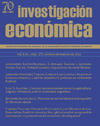THE SOURCES AND EVOLUTION OF INEQUALITY IN MEXICAN EJIDOS
Contenido principal del artículo
Resumen
This paper examines the sources of inequality in the Mexican common property communities (ejidos), both in the past and in the present. It uses as a proxy of historical inequality the distribution of land at the time of the Agrarian Reform, and as a proxy for current distribution the number of cattle held by individuals. Possible hypotheses of factors affecting the distribution are pre-colonial population densities, differing eligibility rules through the course of the Agrarian Reform, and geography. Decomposition of the inequality measures shows that land inequality is much higher between than within ejidos, with the opposite being true for cattle inequality. Higher pre-colonial population densities are shown to decrease the average amount of privateland and of cattle held by ejido members, and to decrease within ejido-land inequality while they increase within-ejido cattle inequality. Ejidos formed during the early periodof the reform have significantly larger land endowments, and much greater inequality within them currently. Finally, geography is an important determinant of both land and cattle distribution within and between ejidos, even while controlling for other factors.This suggests roles for both geography and institutions in the determination of the distribution of assets in rural Mexico.
Detalles del artículo
Cómo citar
Alix-Garcia, J. (2013). THE SOURCES AND EVOLUTION OF INEQUALITY IN MEXICAN EJIDOS. Investigación Económica, 70(278). https://doi.org/10.22201/fe.01851667p.2011.278.37324
Los autores que publiquen en esta revista acceden a las siguientes condiciones:
a) Los autores retienen los derechos de copia (copyright) y ceden a la revista el derecho de primera publicación, con el trabajo asimismo bajo la licencia Creative Commons Attribution License que permite a terceros utilizar lo publicado siempre que hagan referencia al autor o autores del trabajo y a su publicación en esta revista.
b) Los autores son libres de realizar otros acuerdos contractuales para la distribución no exclusiva del artículo que publiquen en esta revista (como puede ser incluirlo en una colección institucional o publicarlo en un libro), siempre que indiquen claramente la publicación original del trabajo en esta revista.
